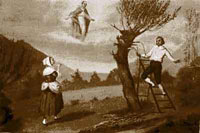"Une Génération Spontanée"
Father Clement Desrochers, o.m.i.: Animateur
-
"Une Génération Spontanée"
Father Clement Desrochers, o.m.i.: Animateur
Henriette Kelker
Research Associate
Provincial Museum of Alberta
Page 2
Clement's entry into the congregation8 of Missionary Oblates seemed to be a natural choice. For health reasons he had made retreats at the Oblate centre Cap-de-la-Madeleine, which was attractive because of the Oblate's Marian orientation and varied ministries. As a boy Clement had read the works of Fr. Duchaissois, o.m.i.9
Clement's interest in working with Canada's aboriginal people was ignited and he hoped to one day work in the Inuit communities in northern Canada. There he hoped to find the outdoors he loved and the people he wanted to serve. In 1933 he entered the Oblate noviciate at Ville La Salle, Quebec, and was ordained to the priesthood on 11 June 1938. In 1940, Fr. Desrochers was called by Bishop Langlois to serve in the Francophone communities of the Peace River District, neither the far north nor an Aboriginal community. Nevertheless, when Fr. Desrochers arrived in Girouxville he felt he had arrived home.
When Fr. Desrochers joined the community the village of Girouxville was still in its early development. Its church, dedicated to Our Lady of Lourdes, had been blessed by Bishop Grouard in 1928. Fr. Desrochers shared his Québécois patrimony with the people of this region. His understanding of what community, Church and family life ought to be like was familiar to them. They shared similar cultural values, spoke the same language and shared a common body of images and ideas which animated what was ultimate in life. For the next ten years he travelled in a horse and buggy to say mass and serve the sacraments in the surrounding area, visit the schools, teach catechism and hear confession. The young people became a special part of his ministry. He noticed that they had little to do in their spare time so he introduced hockey - a sport they did not know. Most did not even know how to skate.
In 1940 the effects of the Great Depression lingered and a moral discouragement was still noticeable. The parish priest, Fr. Nadeau, and Fr. Desrochers succeeded in inspiring the people to become engaged in their own community and new projects began to emerge in rapid succession. Fr. Nadeau had observed how the organisation of co-operatives in the Maritime provinces had brought about change. He now dreamed about something similar in the Peace Country. It was left to Fr. Desrochers to organize a study circle during the winter months.Together they studied "le catéchisme des Caisses Populaires,”10 which provoked lively discussion. The people of Girouxville were inspired to raise the economic and social level by means of co-operatives. In 1941 a credit union was incorporated at Girouxville. A Co-Op store followed, and in 1951 the village of Girouxville itself was incorporated.
The foundation of the co-operatives may have been deliberate, but the Girouxville Museum happened by chance, or what Fr. Desrochers described as "une génération spontanée." One day Fr. Desrochers noticed that a vitrine holding relics of former bishops and missionaries was no longer in the bishop's house in Grouard and learned no one knew where the contents were. Fr. Desrochers received permission to track the artifacts down. He was only successful years later, but as people became aware of his interest in historic material they delivered many artifacts to his quarters. Thus grew the need to house the collection properly. This was initially done in a shed on the pilgrimage grounds in the heart of Girouxville. In 1968, the Museum building was erected. Fr. Desrochers' brother-in-law, Henri Monfette, provided substantial help. Fr. Desrochers convinced Henri that during the hours in which he did not drive the school bus his time was best spent working with his carpentry tools in the Museum. Henri built the log panel interior which gives the Museum its warm atmosphere.
In the Museum, the mission chapel and the personal artifacts from the missionaries and bishops were Fr. Desrochers' pride. Jacques Carbonneau, who had come to Girouxville from Jacques Lake, Quebec, in 1959, shared Fr. Desrochers' passion for the religious artifacts in the Museum. He worked with Fr. Desrochers to organize the pilgrimage and all aspects of the Museum. At Jacques' suggestion the chapel in the Museum was consecrated and Fr. Desrochers came to serve mass here regularly.11 The Girouxville Museum is the only museum in Western Canada where the reserved Sacrament has been present, making its reconstructed chapel a place for prayer at the centre of the Museum.
In 1953 Fr. Desrochers was delegated to go to the Missionary Oblate General Chapter meeting in Rome.12 During this trip he made pilgrimages to various Marian shrines in France: Notre Dame de Lourdes, Notre Dame du Laus, Notre Dame de l'Osier. From these sites he acquired a large number of artifacts - statuary, paintings, and reliquaries. Fr. Desrochers arranged for the objects to be made available to the new Girouxville pilgrimage site. The articles were added free of charge to a shipment destined to the missions in Labrador, from where they travelled by train to northern Alberta. Today they are located in the church, in the grotto, and in the Museum's collection.
Sections
- Page 1
- Page 2
- Page 3
- Page 4
- Settlement of the Peace River Country
- The Co-operative Solution
- Source and Resources


This project has been supported in part by the Canada-Alberta Agreement on French-language Services; the opinions expressed do not necessarily reflect the views of the Governments of Canada or Alberta.




Copyright © 2009 Heritage Community Foundation and
Institut pour le Patrimoine, Campus Saint-Jean, University of Alberta
All Rights Reserved

